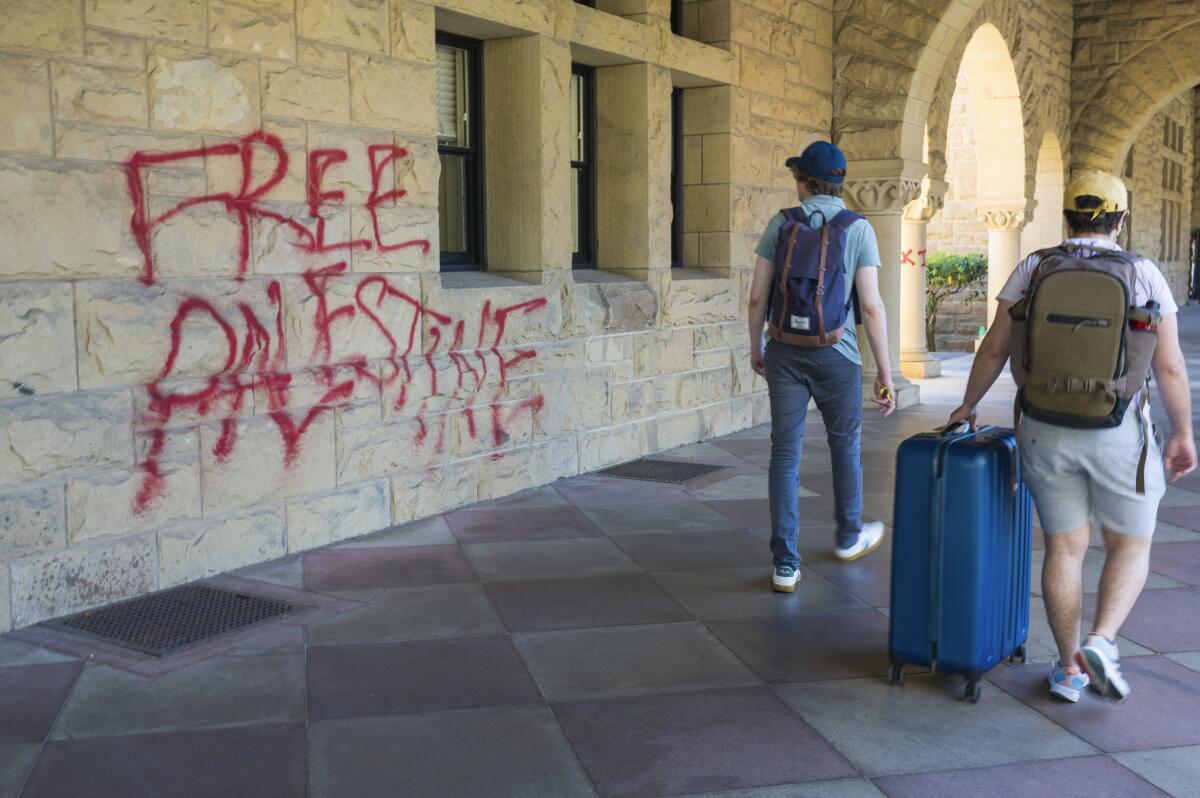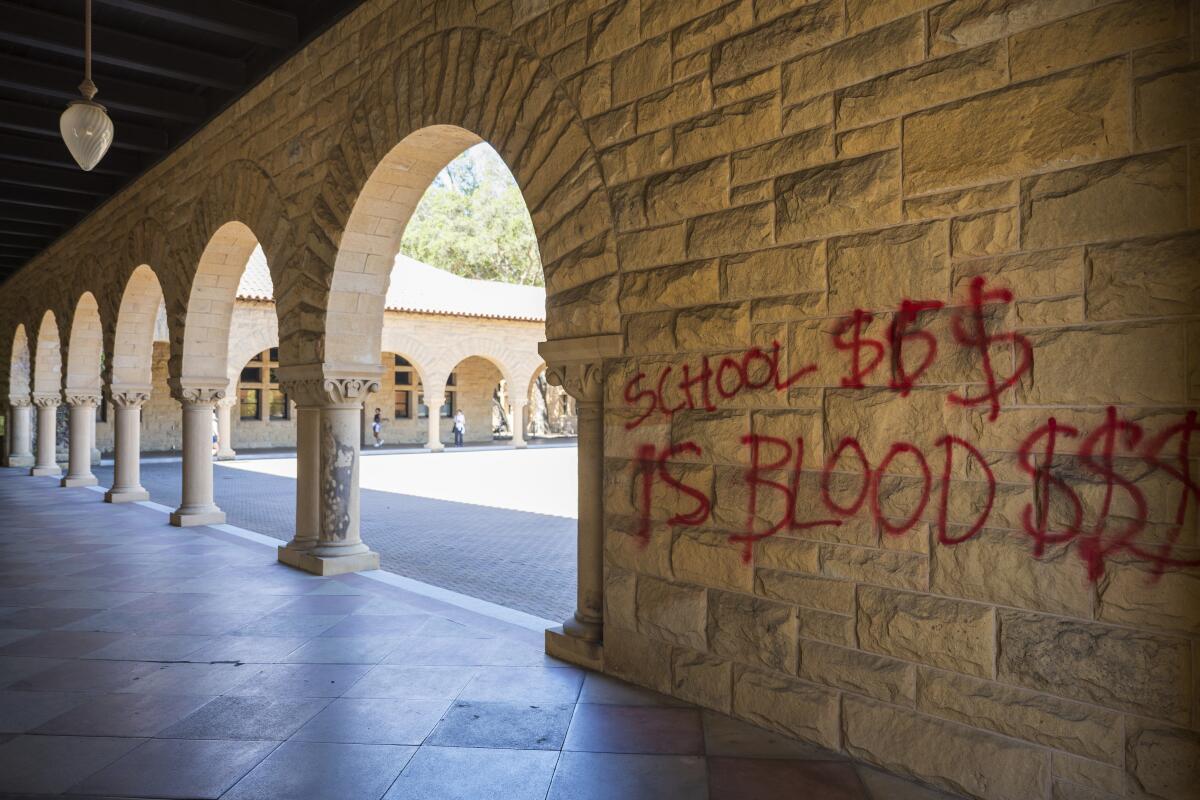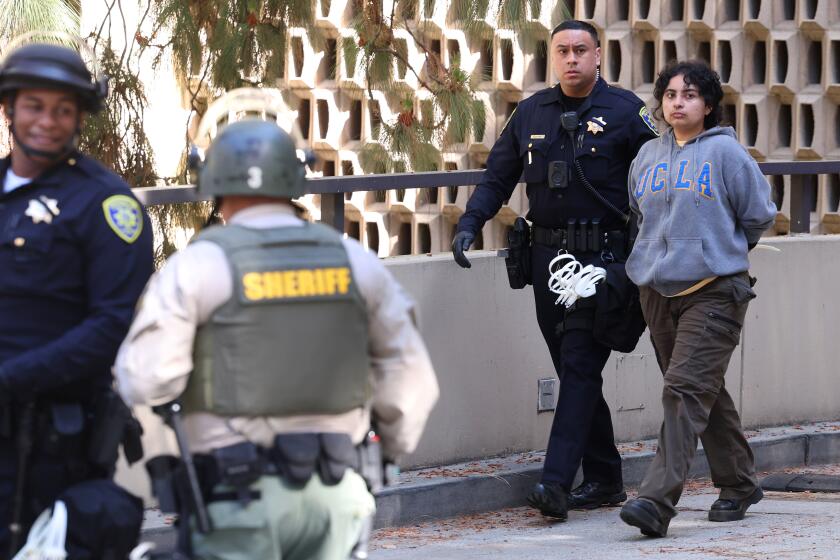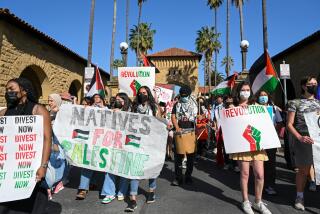‘Dissent is American. Vandalism is criminal.’ Pro-Palestinian Stanford protesters face felony charges

- Share via
- Felony charges have been filed against 12 pro-Palestinian protesters allegedly involved in vandalism at Stanford University.
- The charges are among the most serious faced by those involved in campus protests last spring.
Prosecutors on Thursday announced felony charges against 12 pro-Palestinian protesters — all but one current and former Stanford students or graduates — who in June allegedly broke into and vandalized a Stanford University administration building, barricading themselves inside before being arrested that same day.
The charges against the 12 appear to represent the most serious prosecution en masse to date in California of those arrested during demonstrations and encampments that roiled campuses last spring in protest of Israel’s war in Gaza.
“Dissent is American. Vandalism is criminal,” said Santa Clara County Dist. Atty. Jeff Rosen. “There is a bright line between making a point and committing a crime. Unfortunately, these defendants crossed the line into criminality when they broke into those offices, barricaded themselves inside and started a calculated plan of destruction.”

An attorney representing protester Hunter Taylor-Black said his client understood there would be consequences, but stressed that his client and others have had months-long suspensions, costing them their housing, health insurance and classes — and putting their academic futures in limbo.
“After going through all of that, now they face this,” said attorney Tony Brass.
A Stanford spokesperson confirmed that the students who were charged Thursday received two quarter suspensions “followed by probation, delayed degree conferrals, and community service hours.” The school would “respect” the district attorney’s decision on the criminal case, said Dee Mostofi.
At the time of the predawn takeover, the defendants ranged in age from 19 to 32 and included both current Stanford students and graduates. Prosecutors allege that they broke windows and furniture, splashed fake blood and disabled security cameras in Building 10, where the Stanford president’s office is located.
The building occupation resulted in an estimated $250,000 in damages.
The protesters are charged with felony vandalism and felony conspiracy to trespass.

Those facing charges are: Maya Burke, 29; Zoe Edelman, 21; Eliana Fuchs, 25; German Gonzalez, 21; Gretchen Guimarin, 23; Taylor McCann, 32; Cameron Pennington, 23; John Richardson, 20; Hunter Taylor-Black, 25, Isabella Terrazas, 23; Kaiden Wang, 22; and Amy Zhai, 22.
Escalating protests
The break-in occurred at about 5:30 a.m. on June 5 and the action also involved spray-painting the outside of buildings. One or more participants broke a window to enter the building and let in the others. Before the cameras were covered, “multiple suspects were recorded carrying equipment into Building 10 and barricading doorways using ladders, furniture, and additional equipment they brought into the building,” prosecutors alleged in a news release. “Suspects inside the building began recording social media videos that listed a series of demands.”
The protesters vowed they would not leave until administrators met their demands to divest from Israel, but law enforcement quickly descended, breaking through barricades and entering at about 7 a.m.
Participants were released within hours, but were immediately suspended, according to a statement last June from the university. Seniors were also not allowed to graduate.
In that statement, university officials condemned the protest action and said that a campus safety officer was injured during the building occupation. There was also “extensive graffiti vandalism on the sandstone buildings and columns” with “vile and hateful sentiments that we condemn in the strongest terms.”
Liberate Stanford, an autonomous group of Stanford University students that organized the building takeover, accused law enforcement of “violently assault[ing] a peaceful student protester” as officers prepared to enter.
After the students were arrested, the university shut down activists’ encampment at White Plaza, which officials had allowed to remain even though they said it violated university policies on overnight camping, equitable access to the plaza and use of amplified sound.
Brass, the student’s attorney, said he understands that activism is no license for criminality, but “the voice of student protesters has been important in American history. And this was a symbolic gesture to draw attention to a cause for which the students felt a legitimate sense of urgency, with the death toll [in Gaza] rising by the day. ... Whatever your politics are, wanting to stop infant deaths immediately — one could understand. I hope that the district attorney’s office sees fit to act with a certain measure of tempering justice with mercy.”
The charges carry a maximum punishment of three years and eight months in state prison, but the district attorney said that incarceration was an unlikely outcome.
Rosen said that he’d like the defendants to plead guilty and make restitution to Stanford. He added that the case was not about the protesters’ politics.
“We would not be here today if these defendants stopped at the threshold of Building 10 and simply stated their views,” he said.
Student supporters don’t see it that way.
“Instead of listening to their demands for justice and accountability, our institutions have chosen repression,” said Zahra Billoo, executive director of the San Francisco Bay Area affiliate of the Council on American-Islamic Relations. “Prosecuting these young people with felony charges is a blatant attack on free speech.”
Student journalist not charged
Dilan Gohill, a first-year student, was also arrested as he was reporting from the scene for the Stanford Daily newspaper, embedded inside the building with the protesters.
For months, the Stanford administration had urged the prosecution of Gohill along with the others, but eventually backed away from that position under a deluge of groups that came to Gohill’s defense.
According to Columbia Journalism Review, university officials soon allowed Gohill to return to campus — while the students who were among the protesters were suspended for longer periods.
Few major charges
The Stanford prosecutions represent among the most serious consequences for the more than 3,200 pro-Palestinian protesters arrested at 73 college campuses between April and July last year. The tally is based on an Associated Press review of records and survey of students, universities and district attorneys.
Some of the largest demonstrations and arrest tolls unfolded in California, including at UCLA and USC, where students demanded universities divest from financial ties to Israel.
More than 100 demonstrators were arrested at campuses that included Columbia University in New York, Emerson College in Boston and the University of Massachusetts Amherst.
As of November, the Appeal, a left-of-center nonprofit news organization, found that the largest number of cases were in limbo, with most of the rest not resulting in felony prosecutions.
Many students have seen charges dismissed, but cases remain unresolved for hundreds of protesters at campuses with the highest number of arrests.
In California, a Times and AP analysis reached similar conclusions, although even without prosecutions, students faced serious campus disciplinary consequences.
There is a one-year period in which misdemeanor charges can be filed — meaning that a deadline is approaching for the resolution of many cases.
Last month, a group of pro-Palestinian protesters sued UCLA over its handling of demonstrations last spring, including an incident in which a vigilante mob attacked their encampment on campus in the middle of the night. The suit identified 20 alleged assailants who carried out the attack, and some of the violence was captured on video.
The Los Angeles County district attorney’s office has not filed a case related to that incident. Prosecutors weighed felony assault charges against Edan On, 19, who was first identified among the attackers in a 2024 CNN report and captured on video striking a pro-Palestinian protester with a pole.
While prosecutors confirmed On certainly committed an “assault,” they referred the case to the L.A. city attorney’s office due to his age, lack of criminal history and the minimal injuries suffered by his victim. A spokesman for the city attorney’s office said On’s case was still being reviewed.
Times staff writer James Queally contributed to this report.
More to Read
Sign up for Essential California
The most important California stories and recommendations in your inbox every morning.
You may occasionally receive promotional content from the Los Angeles Times.














